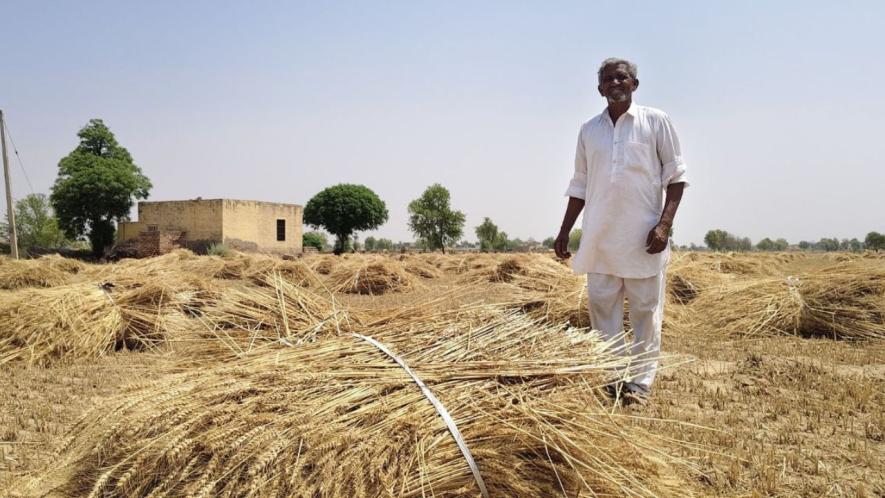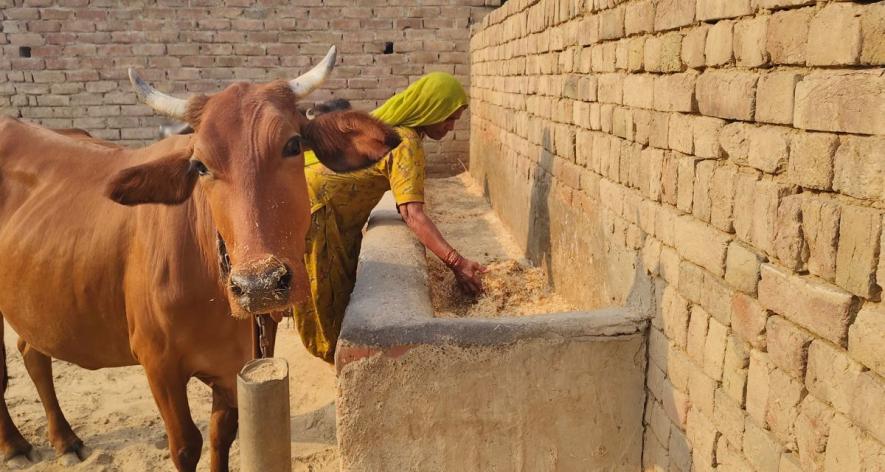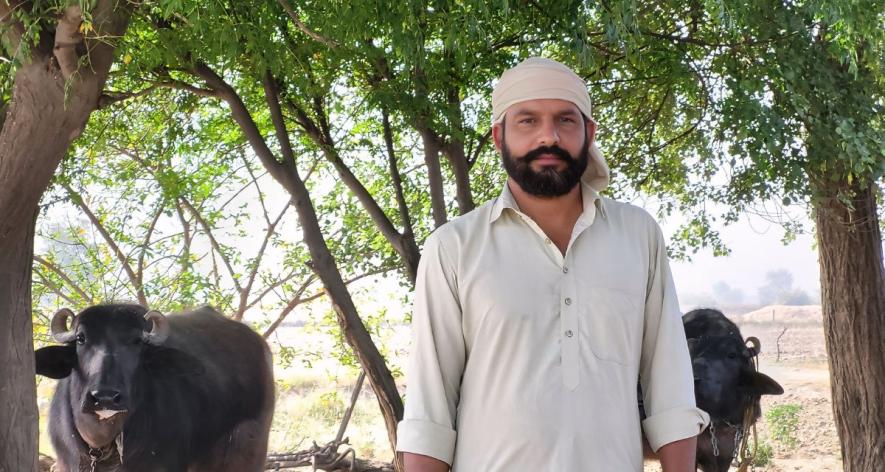Rajasthan: It's Tenant Farmers, Not Landowners, Who Bear Burden of Climate Change

Kaluram Solda, a farmer from Charanvasi village (Photo - Jayalal Verma)
Sri Ganganagar, Rajasthan: In Rajasthan’s Sri Ganganagar and Hanumangarh districts — popularly known as “Mini Punjab” — farming is no longer a promise of prosperity. Climate change has turned it into a gamble.
This winter, unseasonably warm weather wiped out carrot crops sown across thousands of hectares in the two districts located near the Punjab border.
“No one could have guessed this would happen. We had to resow the entire field,” Amar Singh Bishnoi, a farmer from Sadhuwali village, told 101Reporters.
Farmers said erratic weather makes it harder to plan crops. As uncertainty rises, landowners lease out land, leaving tenants to shoulder the risks.
“They’re the ones pushed to the edge,” said Raghuveer Verma of the All India Agricultural Workers' Union. “Climate change is hitting the poor and landless the hardest and upending long-held farming patterns.”
Stuck in losses
For years, Sandeep Bishnoi (38), a farmer from Bhagatpura village in Sangaria tehsil, and his brother cultivated not only their 11 bighas of ancestral land but also leased 10-20 bighas from nearby farmers.
This year, they stopped after rent rose from Rs 22,000 to 30,000 per bigha.
“How long should we bear the loss?” Bishnoi said. “We’ve had four bad years. Pink bollworm and unseasonal rains destroyed our cotton crops three years in a row.”
Rent isn’t the only burden. The cost of cultivation — including seeds, fertilisers, pesticides and tractor rent — can go up to Rs 20,000 per bigha. Factoring in rent and other inputs, Bishnoi said, “We spend nearly Rs 50,000 per bigha, excluding our own labour cost. But the returns don’t match. We’re drowning in debt.”
In 2024, the family borrowed Rs 3 lakh under the Kisan Credit Card scheme at 1% interest and another Rs 1.5 lakh from local commission agents at 2% interest.
“The year the crop is good, the landowner raises the rent. But when the crop fails, the rent stays the same,” he added.

Farming is no longer a promise of prosperity (Photo - Amarpal Singh Verma, 101Reporters).
Hot and cold
Farmers in Rajasthan’s northern districts say the weather no longer follows a predictable rhythm.
“When it rains, it rains at the wrong time. When we need it, the skies are dry,” said Kaluram Solda, a farmer from Charanvasi village in Hanumangarh district.
In January 2025, average temperatures exceeded 20°C — 4 to 5 degrees above normal — affecting the Rabi crops that typically require cooler, stable weather.
February and March saw more fluctuations. While temperatures in Sangaria village of Hanumangarh district remained below 30°C due to unseasonal rains, Sri Ganganagar experienced a steady spike, reaching highs of 36°C by March 23.
“During Kharif season, crops like cotton, green gram and guar falli (cluster bean) often fall prey to unseasonal rains, storms and hail at the time of sowing. Farmers also have to worry about a rise in pest infestation due to the unpredictable weather,” Bishnoi said.
“Pesticide sprays have increased from two to five rounds, raising costs,” he added.
“This is part of a larger pattern,” said Dr Raghuveer Singh Meena of the Agricultural Research Centre in Sri Ganganagar. “Even February and March now see sharp rises in temperature that are disastrous for rabi crops.”
Rainfall patterns have also swung wildly. Sangaria recorded just 2.41 mm of rain in January 2022, which jumped to 21.5 mm in January 2025.
Hailstorms and sudden downpours — like those on April 11 in Nohar tehsil of Hanumangarh — have flattened standing crops overnight. Earlier, on March 15, heavy rains and strong winds had damaged wheat and mustard crops in Sri Ganganagar district.
Even traditionally resilient crops like kinnow are suffering. Farmers have uprooted orchards after repeated losses.
Dr Anoop Kumar, Chief Scientist of the Agricultural Science Centre in Sangaria said, “The climate of the area has changed a lot, which is affecting the farming patterns."
Even Solda has scaled back this year. Instead of renting three acres of land like he usually did, he has taken only one. Along with the one acre he owns, he has planted cotton on both acres. “If it rains now, the cotton seeds will get kurand,” he said.
Cotton is typically sown in May in this region, though some farmers start in April if the weather gets too hot. But unexpected rainfall after sowing can ruin the crop. When fields flood, cotton seeds rot and fail to sprout: a condition called kurand. If this happens, they are forced to sow again, and if the window closes, cotton can't be grown at all. In such cases, farmers switch to alternative crops like moong or guar.
Earlier, the seasons were predictable, and the Agriculture Department advised farmers on sowing timelines accordingly. For example, wheat was recommended to be sown between November 1 and 25, with delayed sowing permitted up to December 15. But now, because of rising temperatures and changing weather patterns, sowing often happens at the end of December, sometimes even in January. Similarly, while cotton sowing is officially recommended by May 20, farmers rarely follow this anymore due to shifting climate conditions.
“The sun feels like fire now,” said Anusuiya Sharma (55), standing in her six-bigha field in Nathwana village. “We’ve always worked through heat and cold, but now the intensity causes dizziness.” Last year, she says, the cold was also so intense it felt like “it had frozen like snow”.
She said, “Too much heat before Holi ruined our wheat. Cotton was lost to unseasonal rain and pests. Fortunately, this time wheat and mustard survived.”
Her husband Ramkumar Sharma (60) said, “Earlier I used to take four bighas of land on rent… But after so many crop failures, we stopped renting any additional farms. Now I sometimes work as a labourer for Rs 400 a day to make some more income.”
Satnam Singh (30) incMeharwala village has also been facing continuous losses on the 10 bighas of land he cultivates. In 2022, wheat failed due to extreme heat, and the cotton crop was destroyed by pink bollworms. In 2023, though the wheat yield was good, hailstorms wiped out the harvest. That year’s cotton was again hit by pest infestation. In 2024, heavy rains ruined his peanut, cotton, and guar crops, and the damage was compounded by the pink bollworm.
“This year’s wheat crop has finally offered some relief, a harvest of 72 quintals from six bighas, but even that is not enough,” he said.
“Half the wheat went to the landowner. With what’s left, I can repay only Rs 20,000–30,000 of my loan, it won’t make a dent,” Singh added.

Sandeep Bishnoi, a farmer from Bhagatpura village (Photo - Amarpal Singh Verma, 101Reporters).
Leasing out worries
Former Deputy Sarpanch Gurcharan Singh (60) owns 12 bighas of land in Meharwala village. “Until six or seven years ago, I farmed it myself. But because of canal water shortages and erratic rainfall, I gave half the land for sharecropping. For three to four years, I didn’t earn anything.” Now, he’s planning to lease out the land instead. “At least with rent, I’ll get a fixed income.”
In sharecropping (batayi), costs and harvests are shared. In rental farming (kiraye par), tenants bear all costs and risks.
To understand this shift, it is important to trace the history of landholdings in Rajasthan. The total area of Sri Ganganagar and Hanumangarh districts is about 20.6 lakh hectares, out of which nearly 74% is used for farming.
In 1994, when Hanumangarh was carved out of Sri Ganganagar to become a separate district, the average landholding per farmer there was 6.01 hectares. But according to the 2015-16 Agriculture Census data, this average fell to 4.51 hectares. Since then, no new agricultural census has been conducted, but the average is expected to have dropped further.
In 1994-95, the number of small farmers (with land between 1 and 2 hectares) in Hanumangarh was 18,917. By 2015-16, this number had increased to 35,327.
As families grow and land is divided across generations, the number of marginal and small farmers has ballooned. With less land to farm and limited access to irrigation or credit, many of these smallholders are turning to tenant farming.
Ashok Jalandhar, a freelance journalist from Sri Ganganagar, said: “People with tiny holdings lease land from absentee landlords or relatives. But tenant farmers get no institutional support, no insurance, and no formal recognition.”
Out of the institutional net
“Landless cultivators take loans at high interest from commission agents, and after giving the landowner their share, they’re left with nothing. Most can’t access institutional loans or crop insurance schemes because they don’t have formal land titles.”
Even those who farm on rent face similar issues. Verma said, “Landowners get the fields insured but keep the money. Sharecroppers or leaseholders rarely benefit. There's no prohibition on including tenant farmers in Rajasthan, but the government maintains no records and landowners resist this due to fear of land rights being claimed by tenants.”
Tenant and sharecropper farmers often lack Khatedari rights—official documentation of land ownership or tenancy—which blocks their access to: Fasal Bima Yojana (crop insurance), Kisan Credit Cards, PM Kisan Samman Nidhi (income support scheme).
Landowners usually register for these benefits but do not pass them on to those actually cultivating the land. The state doesn’t track tenancy arrangements, leaving tenant farmers outside formal safety nets.
Without access to banks, tenant farmers rely on adhatiyas (commission agents) for everything: loans, seeds, fertilizer, and even rations. In return, they sell their harvest to these agents, often at non-MSP prices.
Hardeep Singh, a farmer from Sangaria, explains: “We’ve been farming for generations. If we stop now, who will give us ration or credit? Commission agents have been our lifeline.”
Voices from the ground
Most farmers stick to traditional crops and cropping patterns despite the losses, not by preference, but because they simply cannot afford to take chances.
While agricultural departments and Krishi Vigyan Kendras share weather alerts and crop advisories via newspapers and WhatsApp, it is too little for them to secure their crops.
“Climate change isn’t in our control. We try to live in harmony with nature,” said Rampal Jat, National President of the Kisan Maha Panchayat.
The government should step in, he said, especially to ensure that even non-accountholder farmers like leaseholders and sharecroppers have access to crop insurance, Kisan Credit Cards and subsidies.
Jat referred to a 2015 high-level committee led by agricultural economist T Haque, which had submitted a report on land leasing reforms to NITI Aayog. “If laws are made based on that report, many of these problems can be addressed,” he said.
Jalandhar added: “With climate change intensifying, agricultural losses are only expected to rise.”
This concern is reflected in the 2019 IPCC Special Report on Climate Change and Land, which warns that a 1.5°C rise in global temperatures could lead to a 9% drop in India’s production of pulses, paddy, wheat, and coarse grains by 2050.
Amarpal Singh Verma is a freelance journalist and a member of 101Reporters, a pan-India network of grassroots reporters.
Get the latest reports & analysis with people's perspective on Protests, movements & deep analytical videos, discussions of the current affairs in your Telegram app. Subscribe to NewsClick's Telegram channel & get Real-Time updates on stories, as they get published on our website.
























